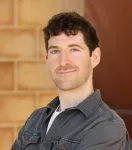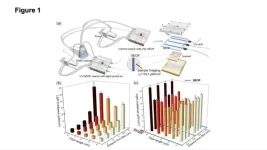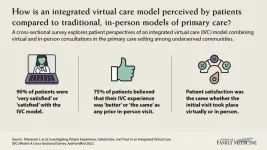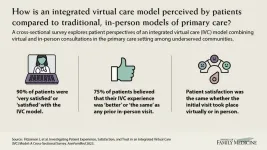(Press-News.org) LA JOLLA, CA—Immune system researchers have designed a computational tool to boost pandemic preparedness. Scientists can use this new algorithm to compare data from vastly different experiments and better predict how individuals may respond to disease.
“We’re trying to understand how individuals fight off different viruses, but the beauty of our method is you can apply it generally in other biological settings, such as comparisons of different drugs or different cancer cell lines,” says Tal Einav, Ph.D., Assistant Professor at La Jolla Institute for Immunology (LJI) and co-leader of the new study in Cell Reports Methods.
This work addresses a major challenge in medical research. Laboratories that study infectious disease—even laboratories focused on the same viruses—collect wildly different kinds of data. “Each dataset becomes its own independent island,” says Einav.
Some researchers might study animal models, others might study human patients. Some labs focus on children, others collect samples from immunocompromised senior citizens. Location matters too. Cells collected from patients in Australia might react differently to a virus compared with cells collected from a patient group in Germany, just based on past viral exposures in those regions.
“There’s an added level of complexity in biology. Viruses are always evolving, and that changes the data too,” says Einav. “And even if two labs looked at the same patients in the same year, they might have run slightly different tests.”
Working closely with Rong Ma, Ph.D., a postdoctoral scholar at Stanford University, Einav set out to develop an algorithm to help compare large datasets. His inspiration came from his background in physics, a discipline where—no matter how innovative an experiment is—scientists can be confident that the data will fit within the known laws of physics. E will always equal mc2.
“What I like to do as a physicist is collect everything together and figure out the unifying principles,” says Einav.
The new computational method doesn’t need to know precisely where or how each dataset was acquired. Instead, Einav and Ma harnessed machine learning to determine which datasets follow the same underlying patterns.
“You don’t have to tell me that some data came from children or adults or teenagers. We just ask the machine ‘how similar are the data to each other,’ and then we combine the similar datasets into a superset that trains even better algorithms,” says Einav. Over time, these comparisons could reveal consistent principles in immune responses—patterns that are hard to detect across the many scattered datasets that abound in immunology.
For example, researchers could design better vaccines by figuring out exactly how human antibodies target viral proteins. This is where biology gets really complicated again. The problem is that humans can make around one quintillion unique antibodies. Meanwhile a single viral protein can have more variations than there are atoms in the universe.
“That’s why people are collecting bigger and bigger data sets to try and explore biology’s nearly infinite playground,” says Einav.
But scientists don’t have infinite time, so they need ways to predict the vast reaches of data they can’t realistically collect. Already, Einav and Ma have shown that their new computational method can help scientists fill in these gaps. They demonstrate that their method to compare large datasets can reveal myriad new rules of immunology, and these rules can then be applied to other datasets to predict what missing data should look like.
The new method is also thorough enough to provide scientists with confidence behind their predictions. In statistics, a “confidence interval” is a way to quantify how certain a scientist is of a prediction.
“These predictions work a bit like the Netflix algorithm that predicts which movies you might like to watch,” says Einav. The Netflix algorithm looks for patterns in movies you’ve selected in the past. The more movies (or data) you add to these prediction tools, the more accurate those predictions will get.
“We can never gather all the data, but we can do a lot with just a few measurements,” says Einav. “And not only do we estimate the confidence in predictions, but we can also tell you what further experiments would maximally increase this confidence. For me, true victory has always been to gain a deep understanding of a biological system, and this framework aims to do precisely that.”
Einav recently joined the LJI faculty after completing his postdoctoral training in the laboratory of Jesse Bloom, Ph.D., at the Fred Hutch Cancer Center. As he continues his work at LJI, he plans to focus on the use of computational tools to learn more about human immune responses to many viruses, beginning with influenza. He’s looking forward to collaborating with leading immunologists and data scientists at LJI, including Professor Bjoern Peters, Ph.D., also a trained physicist.
“You get beautiful synergy when you have people coming from these different backgrounds,” says Einav. “With the right team, solving these big, open problems finally becomes possible.”
The study, “Using Interpretable Machine Learning to Extend Heterogeneous Antibody-Virus Datasets,” was supported by the Damon Runyon Cancer Research Foundation (grant DRQ 01-20) and by Professor David Donoho at Stanford University.
DOI: https://doi.org/10.1016/j.crmeth.2023.100540
About La Jolla Institute
The La Jolla Institute for Immunology is dedicated to understanding the intricacies and power of the immune system so that we may apply that knowledge to promote human health and prevent a wide range of diseases. Since its founding in 1988 as an independent, nonprofit research organization, the Institute has made numerous advances leading toward its goal: life without disease. Visit lji.org for more information.
END
New algorithm may fuel vaccine development
Computational biologists harness machine learning to make sense of immune system data
2023-07-25
ELSE PRESS RELEASES FROM THIS DATE:
Shedding light on a dark problem
2023-07-25
Bacterial biofilms are clusters of microorganisms that form on wetted surfaces virtually everywhere. They harbor pathogens that compromise water quality, and they can disrupt the operation of many different engineered systems through the corrosion, fouling and clogging of tanks, pipes and valves.
In some settings, they could even be deadly. Space suits that enable crew operations outside of the International Space Station use recirculating water to regulate body temperatures in the orbital extremes of full sun (250 F) and full shade (-250 F). But biofilms blooming in those water lines have nearly compromised astronaut safety during ...
Scientists may have discovered mechanism behind cognitive decline in aging
2023-07-25
AURORA, Colo. (July 25, 2023) – Scientists at the University of Colorado Anschutz Medical Campus have discovered what they believe to be the central mechanism behind cognitive decline associated with normal aging.
“The mechanism involves the mis-regulation of a brain protein known as CaMKII which is crucial for memory and learning,” said the study’s co-senior author Ulli Bayer, PhD, professor of pharmacology at the University of Colorado School of Medicine. “This study directly suggests specific pharmacological treatment strategies.”
The study was published today in the journal `Science Signaling.’
Researchers using ...
Study shows that the shape of objects could be perceived via vision and touch
2023-07-25
Study shows that the shape of objects could be perceived via vision and touch; the inferolateral occipitotemporal cortex selectively encodes object shape even in people who become blind from a very early age, suggesting that the brain is organized as operators that execute a given function regardless of input senses.
#####
In your coverage, please use this URL to provide access to the freely available paper in PLOS Biology: http://journals.plos.org/plosbiology/article?id=10.1371/journal.pbio.3001930
Article Title: Similar object shape representation encoded in the inferolateral occipitotemporal ...
Understanding social media discussions about female genital mutilation
2023-07-25
Conversations on social media about female genital mutilation (FGM) have not changed dramatically over the five years to 2020, according to an analysis of English Twitter data, though there was a shift from raising awareness to calling for an end to the practice. Earlier on, users discussing the topic were mainly from the USA and UK, but later the majority came from Nigeria and Kenya. The research, published in PLOS Global Public Health, may be useful in informing communication and designing culturally effective campaigns ...
Researchers examine the impact of loan repayment program enrollment on physician workforce equity and patient care access
2023-07-25
Researchers from the American Board of Family Medicine and the University of Minnesota Medical School investigated whether participation in medical school repayment programs impacted the care family physicians provided to patients post graduation. By analyzing data from over 10,000 American Board of Family Medicine National Graduate Survey respondents, the authors examined differences in program participation, participant demographics, scope of practice, and the likelihood of serving medically underserved or rural populations.
The study revealed a significant increase in participation in the Public Service Loan Forgiveness (PSLF) program between 2016 and 2020, while participation ...
Calling for cancer centers to lead on climate disaster preparedness
2023-07-25
MIAMI, FLORIDA (JULY 25, 2023) – Cancer centers are uniquely positioned to protect communities and their most vulnerable residents – cancer patients – from climate-driven disasters by bolstering emergency preparedness, noted researchers with Sylvester Comprehensive Cancer Center at the University of Miami Miller School of Medicine, the American Cancer Society (ACS) and collaborating organizations.
Writing in a commentary in the Journal of the National Cancer Institute (NCI), the researchers noted that all 71* of the country’s NCI-designated ...
July/August 2023 Annals of Family Medicine Tip Sheet
2023-07-25
Canadian Patients Report High Levels of Satisfaction From an Integrated Model of Virtual and In-Person Care
In an effort to increase access to care in underserved communities, researchers from the University of Ottawa evaluated the implementation of an integrated virtual care (IVC) model. Their study evaluated the overall experience and satisfaction of patients receiving care through a combination of virtual and in-person visits. A secondary aim was to compare the experiences of patients who had been previously seen in person by a family physician before transitioning to the IVC clinics with those who met their family physician virtually for the first ...
Navigating telemedicine implementation: exploring experiences of primary care clinicians early in the COVID-19 pandemic
2023-07-25
Researchers from Virginia Commonwealth University and Case Western Reserve University conducted weekly and monthly surveys of primary care clinicians to examine the use of telemedicine during the COVID-19 pandemic. The e-surveys were conducted between March 2020 and March 2022 and used convenience sampling. A total of 36 surveys were completed, with an average of 937 respondents per survey, representing clinicians from all 50 states and from multiple specialties.
Initially, respondents reported difficulties in implementing telemedicine, citing challenges with infrastructure and reimbursement mechanisms. However, as time progressed, attitudes toward telemedicine became ...
Canadian patients report high levels of satisfaction from an integrated model of virtual and in-person care
2023-07-25
In an effort to increase access to care in underserved communities, researchers from the University of Ottawa evaluated the implementation of an integrated virtual care (IVC) model. Their study evaluated the overall experience and satisfaction of patients receiving care through a combination of virtual and in-person visits. A secondary aim was to compare the experiences of patients who had been previously seen in person by a family physician before transitioning to the IVC clinics with those who met their family physician virtually for the ...
Researchers unveil the role of primary cilia in facilitating cartilage regeneration after growth plate fractures
2023-07-25
Growth plates (GP), situated at the ends of long bones in children, supply chondrocytes necessary for bone growth. Damage to the growth plate due to fractures often results in arrested bone growth, making it a significant cause of skeletal disorders in children. However, a small percentage of these injuries astonishingly manage to heal themselves, a phenomenon that had remained a mystery until now.
In a new study published in International Journal of Oral Science, Yao Sun from Tongji University and other researchers identified that primary cilia, cellular ...
LAST 30 PRESS RELEASES:
When is it time to jump? The boiling frog problem of AI use in physics education
Twitter data reveals partisan divide in understanding why pollen season's getting worse
AI is quick but risky for updating old software
Revolutionizing biosecurity: new multi-omics framework to transform invasive species management
From ancient herb to modern medicine: new review unveils the multi-targeted healing potential of Borago officinalis
Building a global scientific community: Biological Diversity Journal announces dual recruitment of Editorial Board and Youth Editorial Board members
Microbes that break down antibiotics help protect ecosystems under drug pollution
Smart biochar that remembers pollutants offers a new way to clean water and recycle biomass
Rice genes matter more than domestication in shaping plant microbiomes
Ticking time bomb: Some farmers report as many as 70 tick encounters over a 6-month period
Turning garden and crop waste into plastics
Scientists discover ‘platypus galaxies’ in the early universe
Seeing thyroid cancer in a new light: when AI meets label-free imaging in the operating room
Neutrophil-to-lymphocyte ratio may aid risk stratification in depressive disorder
2026 Seismological Society of America Annual Meeting
AI-powered ECG analysis offers promising path for early detection of chronic obstructive pulmonary disease, says Mount Sinai researchers
GIMM uncovers flaws in lab-grown heart cells and paves the way for improved treatments
Cracking the evolutionary code of sleep
Medications could help the aging brain cope with surgery, memory impairment
Back pain linked to worse sleep years later in men over 65, according to study
CDC urges ‘shared decision-making’ on some childhood vaccines; many unclear about what that means
New research finds that an ‘equal treatment’ approach to economic opportunity advertising can backfire
Researchers create shape-shifting, self-navigating microparticles
Science army mobilizes to map US soil microbiome
Researchers develop new tools to turn grain crops into biosensors
Do supervised consumption sites bring increased crime? Study suggests that’s a myth
New mass spec innovation could transform research
Maternal nativity, race, and ethnicity and infant mortality in the US
Migration-related trauma among asylum seekers exposed to the migrant protection protocols
Jupiter’s moon Europa has a seafloor that may be quiet and lifeless
[Press-News.org] New algorithm may fuel vaccine developmentComputational biologists harness machine learning to make sense of immune system data






